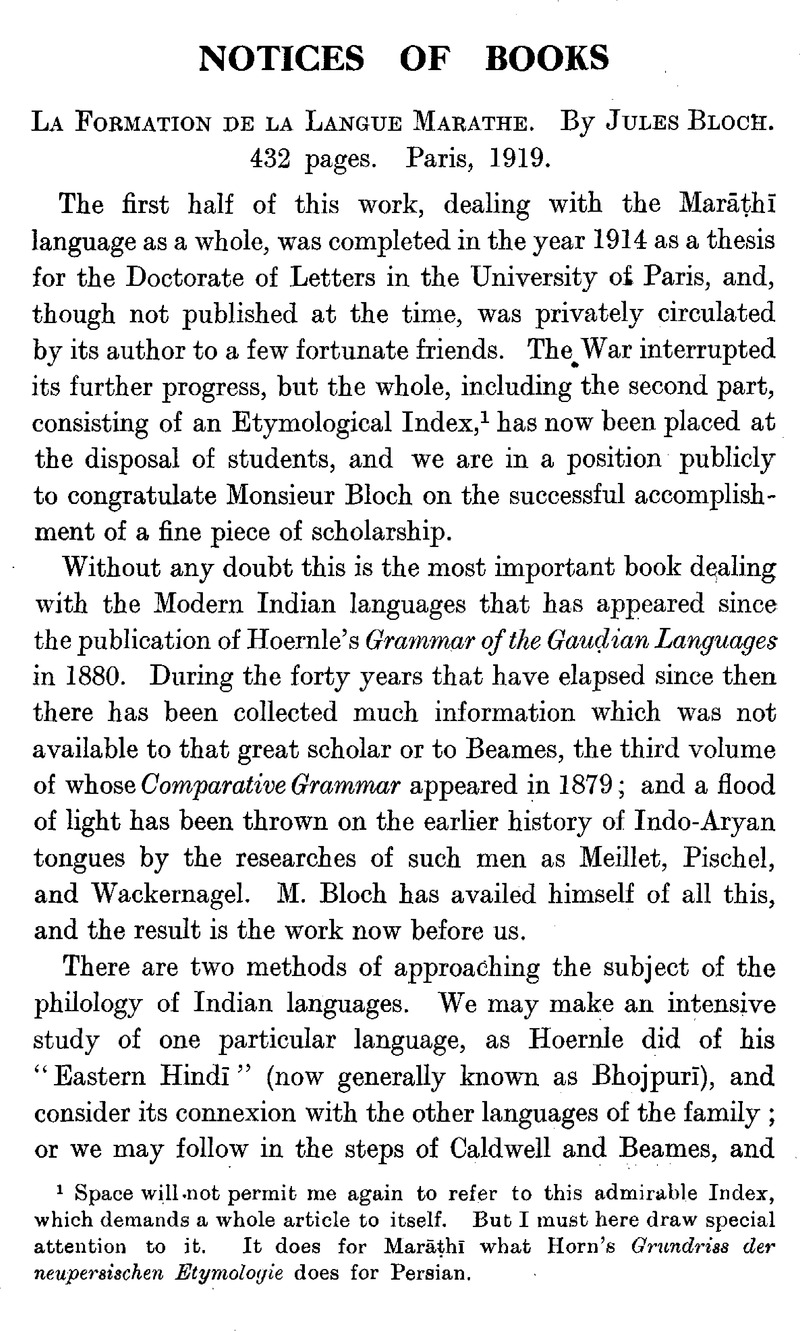No CrossRef data available.
Article contents
La Formation de la Langue Marathe. By Jules Bloch. 432 pages. Paris, 1919.
Published online by Cambridge University Press: 15 March 2011
Abstract

- Type
- Notices of Books
- Information
- Copyright
- Copyright © The Royal Asiatic Society 1921
References
page 251 note 1 Space will-not permit me again to refer to this admirable Index, which demands a whole article to itself. But I must here draw special attention to it. It does for Marāṭhī what Horn's Grundriss der neupersischen Etymologie does for Persian.
page 253 note 1 So Wackernagel, , Altindische Grammatik, I, xixGoogle Scholar: “Somit hat die überall vorkommende, aber in Indien am schärfsten ausgeprägte Scheidung der Sprache nach Volksklassen hier schon in vedischer Zeit geherrscht.”
page 254 note 1 Beames, , i, 236Google Scholar, mentions the names of three Englishmen which the common folk of an India District were never able to distinguish. The names were Kelly, Clay, and Currie.
page 255 note 1 The word was popularly pronounced without the r even in Vedic times. See Wackernagel, , p. i, 167.Google Scholar
page 257 note 1 It is to be noted that, while Hēmacandra, , iv, 446Google Scholar, makes Apabhraṁśa to be based on Śaurasēnī only, with (iv, 329) but a few traces of Mahārāṣṭrī, Mārkaṇḍēya (xvii, 1) states distinctly that Nāgara Apabhraṁśa is based partly on Śaurasēnī and partly on Mahārāṣṭrī. This is an additional reason for using it to explain Marāṭhī. After this review went to press, I have received Professor Jacobi's edition of the Bhavisattakaha, and I am glad to see that the explanation given above agrees in the main with the masterly exposition of Apabhraṁśa contained in that work.
page 257 note 2 See Bulletin of the School of Oriental Studies, vol. i, pt. iii, p. 64.Google Scholar
page 257 note 3 Cf. the prāyaḥ of Vr. ii, 2; Hc. i, 177; Mk. ii, 2.
page 258 note 1 Cf. i, 209.
page 258 note 2 Hc. iv, 396; Mk. xvii, 2. So Kramadīśvara and Rāma Tarkavāgīśa.
page 258 note 3 Hc. iv, 344; Mk. xvii, 9.
page 258 note 4 See Bulletin of the School of Oriental Studies, vol. i, pt. iii, pp. 59 ff.
page 259 note 1 Hc. iii, 132; Mk. v, 131.
page 259 note 2 dēvā-madhy ![]() = dēvasya madhyē, not dēvāya madhyē.
= dēvasya madhyē, not dēvāya madhyē.
page 260 note 1 Even if we admit the derivation of -![]() from -ēna, through -ēṁ, this disappearance of n occurs only because it is final, after the apocope of the final a. The alleged change of -ānām to
from -ēna, through -ēṁ, this disappearance of n occurs only because it is final, after the apocope of the final a. The alleged change of -ānām to ![]() is in no way parallel to this, for here the n is not, and cannot become, final.
is in no way parallel to this, for here the n is not, and cannot become, final.
page 261 note 1 M. Bloch has further developed his remarks about the stress-accent in his article on pp. 359 if. of the R. G. Bhandarkar Commemoration Volume.


